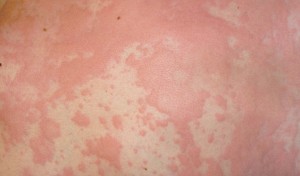By Daniel N. Tucker, M. D. DNT:ns –
 Urticaria and Angioedema are the medical terms for Hives and Giant Hives. The latter can cause extreme swelling involving different areas of the body and can be dangerous when it occurs in the area of the throat. Hives, or urticaria lesions, are raised red areas which are usually quite itchy. These can vary in shape and size. They may be few or can extend over large areas of the body. They may last for only a few minutes or up to hours in duration. Specific hives usually disappear without any trace but can be replaced by additional hives in an on-going fashion. Hives are common, usually manifestations of allergy, and can be brought on by an immense number of agents. Hives can be divided into acute and chronic (all cases are acute at the onset). In acute urticaria, the cause is often obvious because it comes on shortly after taking a specific medication, eating a specific food, or exposure to specific airborne allergens. Chronic urticaria is usually considered urticaria that persists beyond four weeks. As a rule, symptoms are intermittent with periods of being clear, alternating with periods of flares which can be quite uncomfortable. In chronic urticaria, causation can be more difficult to ascertain and the possibilities are myriad. This, however, does not mean that the cause cannot be determined and dealt with.
Urticaria and Angioedema are the medical terms for Hives and Giant Hives. The latter can cause extreme swelling involving different areas of the body and can be dangerous when it occurs in the area of the throat. Hives, or urticaria lesions, are raised red areas which are usually quite itchy. These can vary in shape and size. They may be few or can extend over large areas of the body. They may last for only a few minutes or up to hours in duration. Specific hives usually disappear without any trace but can be replaced by additional hives in an on-going fashion. Hives are common, usually manifestations of allergy, and can be brought on by an immense number of agents. Hives can be divided into acute and chronic (all cases are acute at the onset). In acute urticaria, the cause is often obvious because it comes on shortly after taking a specific medication, eating a specific food, or exposure to specific airborne allergens. Chronic urticaria is usually considered urticaria that persists beyond four weeks. As a rule, symptoms are intermittent with periods of being clear, alternating with periods of flares which can be quite uncomfortable. In chronic urticaria, causation can be more difficult to ascertain and the possibilities are myriad. This, however, does not mean that the cause cannot be determined and dealt with.
Chronic hives are often classified as idiopathic, that is, the doctor does not know what causes them. However, careful history taking and testing can often identify the cause. Drugs and chemicals, particularly antibiotics, are frequent sources of hives as are the various pain medications. Foods may be culprits as may chemical additives and other factors in food. Infections are a common cause and a careful search should be made for these. Common focal areas include the teeth, the sinuses, the gall bladder, and the urinary tract, however, infection in almost any part of the body can cause hives. Viral infections can also bring on hives as can fungal infections and parasites. Hives can be a result of physical contact with allergens or the inhalation of allergens, including pollens. Hives can be associated with insect exposure, endocrine disturbances, and a large number of systemic illnesses. Certain types of hives can be brought on by exercise, pressure, exposure to light, to heat, or in some cases, to cold. Some foods and drugs can cause urticaria, not by an allergic reaction but by the direct action of histamine.
Urticaria is often caused by food. Acute urticaria is more apt to be caused by foods, such as fresh fruits (particularly strawberries), fresh vegetables in season, fish, shellfish, peanuts, and nuts. Chronic or recurrent urticaria is more apt to be caused by foods which are eaten on a regular basis, such as milk and other dairy products, wheat, egg, chocolate, and peanut butter. Hives may begin promptly after ingesting the food but may not appear for some time, up to 24 hours after the ingestion. The food may act as a vehicle for other allergens rather than necessarily being the allergen by itself. Meat, milk, and chicken may contain antibiotics or other drugs or hormones. Foods which have been held in the refrigerator too long may contain significant amounts of mold antigen which can be a powerful antigen. Hives can be associated with thyroid disease and premenstrual and menstrual flare-ups of hives are not uncommon.
Giant hives must be differentiated from hereditary angioedema which is a different phenomena requiring different evaluation and different treatment, Hereditary angioedema is not an allergic condition.Symptomatic treatment of hives usually involves antihistamines which are often quite effective. Cortisone is also effective but usually is not a good idea for long term use. The itching can be relieved by topical agents such as Calamine Lotion or the over-the counter product, Itch-X. Cortisone creams are often used but are usually not very effective. Hive- like lesions that are present for more than 12 hours at a specific site should be biopsied to be sure that a vasculitis is not present. A careful history may lead to a diagnosis. Are the hives related to exercise, mowing the lawn, going to a florist shop or stable, or working with various chemicals, such as apoxy resins? Determining the cause of urticaria should be approached with confidence, since in most cases with persistence, a cause can be found and treated.
Daniel N. Tucker, M.D.
561-835-0055
1411 North Flagler Drive, Suite 6700
(in Victor Farris Building)
West Palm Beach, Forida 33401
Check Also
RejuvaNATION MedSpa: Elevating Men’s Health to New Heights
Embark on a Journey to Revitalize Your Vitality Rediscover the joy of a spontaneous sex …
 South Florida Health and Wellness Magazine Health and Wellness Articles
South Florida Health and Wellness Magazine Health and Wellness Articles




